Tui turned yellow: causes and treatment
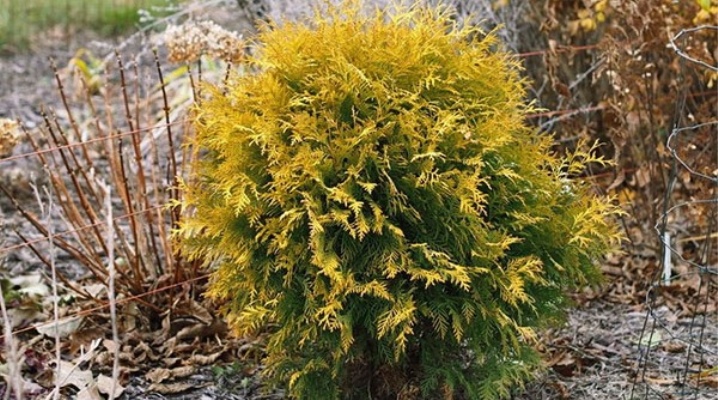
Thuja are often used for landscape design. Beautiful evergreens are able to transform the site and delight with their appearance for many years. Tui are resistant to many diseases and pests, but, unfortunately, troubles happen with them. For example, they may turn yellow.
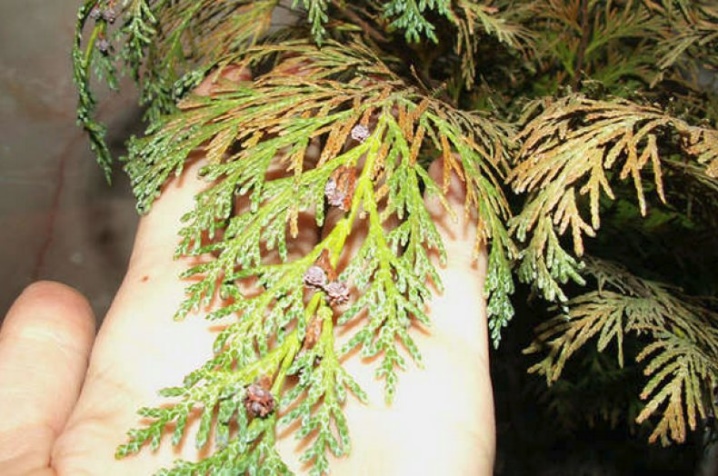
Causes
There are many reasons due to which yellowness appears, however, this condition of the tree does not always require treatment. First of all, you should know that in some cases you should not worry, since unpleasant phenomena are caused by natural processes.
Sometimes inexperienced gardeners buy seedlings of varieties for which yellow shades of needles are the norm. This shade can be red, golden, bronze, lemon is found. This applies to the varieties "Golden Globe", "Sankist", "Miriam", "Yellow Ribbon", "Elvanger golden". It is advisable to use them along with green varieties to create accents in the garden or park ensembles.
The needles are also renewed periodically. Depending on the variety, it can occur every 3-5 years, or even every year. The twigs grow old and die, the needles dry up and fall off. But a new one will grow in its place. In this situation, you just need to remove the dead elements ..
This should be done by hand, without the use of sharp tools, so as not to damage the tree. In the fall, when the plant is preparing for the cold weather, there is no need to clean it. The best time for manipulation is spring
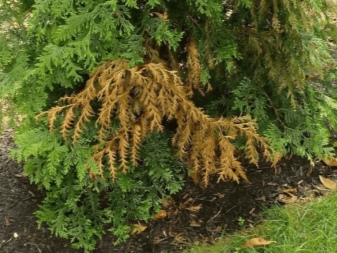
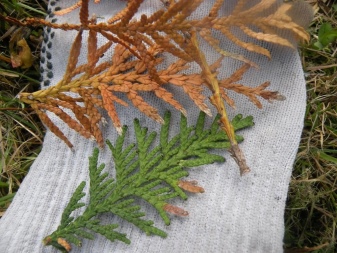
In addition, in some varieties, the color of the needles changes before the onset of cold weather. Although thuja is a frost-resistant plant that survives even in very harsh conditions, its crown still turns yellow, sometimes it turns brown. This is characteristic of thuja folded or thuja western. With the onset of warmth and the resumption of sap flow, the green color will be restored. The return of an attractive appearance will happen on its own, you just need to help the tree with light sanitary pruning. However, there are varieties that do not change color all year round. For example, "Smaragd" will stand out with emerald green even in the most unfavorable winters in terms of weather conditions.
It quite often happens that thuja turned yellow after winter. This is often the result of sunburn. The bright spring sun, whose rays reflect the snow, is very intense. The plant, weakened during the long winter, suffers from a lack of nutrients, its protective reserves are depleted, and the tree gets burned. But even in this case, the restoration will occur quite quickly, with proper care.
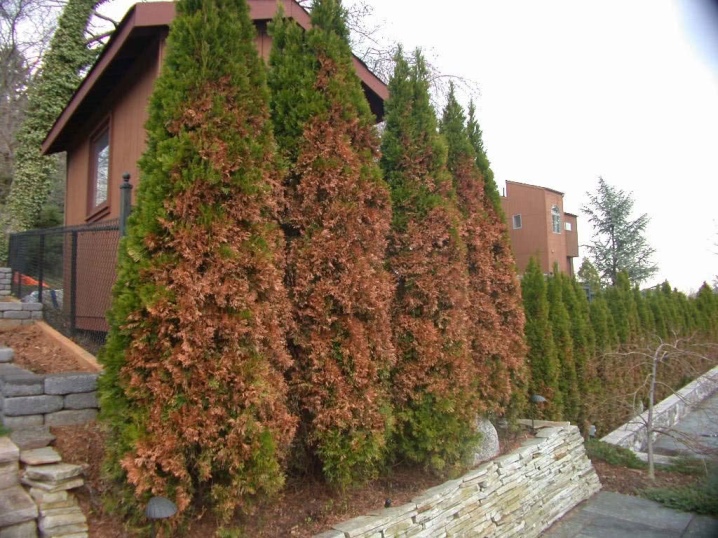
Negative phenomena are caused by improper landing, choosing the wrong place. Novice gardeners often do not have enough experience to meet all the necessary conditions, as a result, the thuja dries up, and in the first year it can completely turn yellow. There are several factors that trigger the problem.
- Groundwater is very close to the surface. The root system rots, and, as a result, the branches dry out.
- Unsuitable soil. It should be neither clayey nor sandy. In the first, moisture stagnates, in the second there is not enough moisture. And also the presence of a large amount of peat is not suitable.
- The root collar was too deep or bare during planting. Tree growth is inhibited, stem rot may appear.
- Thickened fit. Maturing thuja interfere with each other, their root systems become cramped.The branches touch tightly, the air circulation is disturbed, which causes delusion, yellowing and discharge of needles.
- An abundance of sunlight. Thuja planted in an open area will inevitably turn yellow if the number of clear days is large. In addition, in an open space, the negative effect will be intensified by drafts, which the thuja cannot tolerate.

Errors in care can also lead to the appearance of yellowness.
- Excessive or insufficient watering. If the plant does not have enough moisture, especially during the dry period, then the ends of the needles will acquire a brown tint.
- Insufficient amount of applied fertilizer. Iron deficiency will affect the condition of individual areas and young shoots: they will lose pigmentation and become pale. If there is not enough phosphorus, then a reddish-purple hue will appear. However, an excessive amount of fertilizers will have a bad effect on the decorative qualities of thuja.
Unfortunately, thuyu can be afflicted with diseases. In early spring, when the snow melts, in some cases traces of parasitic fungi and mold are found. If treatment is not taken in time, they will spread and cause not only a changed color of the needles, but also the death of young plants. And also the tree can suffer from the invasion of insect pests.
It happens that in a healthy and well-groomed plant, the lower part of the crown unexpectedly turns yellow. See if your pets, dogs and cats, are the culprit. Their labels can have a similar effect.
Another factor contributing to the appearance of yellowness can be the proximity of large highways and busy streets, where reagents are used to quickly melt snow. Despite the persistence of thuj, melt water containing reagents and corrosive substances from car exhaust sometimes infects the root system.

How to treat?
If you find a subtle yellowing from the inside of the trunk, then this is, obviously, a normal process of withering away of old needles. When the yellowing is massive, then an urgent need to look for the cause and carry out adequate treatment. If the thuja has suffered from sunburn even in the presence of shelter, then with the onset of heat and the disappearance of snow, the dried branches must be removed and the trees watered abundantly. It will not be superfluous to spray them with growth stimulants. Suitable "Epin" or "Zircon" intended for conifers.
For thickened plantings, no specific treatment is required. The situation is saved by the timely planting of plants. For their full-fledged growth and development, it is necessary that the distance to the nearest "neighbor" is about 1 m.
Errors detected during planting and site selection are corrected by establishing drainage, adding the necessary elements to the soil (sand or peat), mulching. Choosing a more suitable transplant site is a good decision. And you should also provide proper care: regularly water and fertilize.

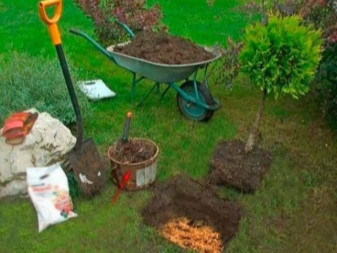
If fungal and mold lesions are found during the spring examination, treatment should be started immediately. First of all, you need to carry out sanitary pruning, carefully removing all infected branches, and destroy them. The cut sites are disinfected with copper sulfate (5% solution), and then a fungicide with a wide range of effects is applied. "Fitosporin", "Skor", "Guardian" have proven themselves well. Directions for use and doses are indicated on the package. However, if the plant is infected with late blight, treatment may be useless. The tree must be dug up and burned.
The invasion of insects greatly reduces the defenses of the thuja, it can turn yellow and die. In this case, it is necessary to treat the plant from yellowness with special means. Their choice depends on the type of pest. For example, you can get rid of aphids using a soapy solution. It is used once a week until the insects disappear completely.
One of the common pests of thuja is a false shield. It is quite possible to mechanically free the plant from a small number of individuals. With large numbers, you can fight using "Aktara" or "Actellic". The procedure is carried out 2-3 times, the interval is 10 days. In addition to the spring, summer processing is carried out to prevent the development of new larvae.
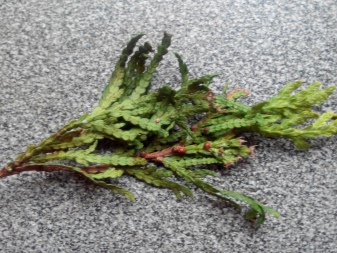

After getting rid of insects, it is required to restore the health of the thuja with the help of mineral dressings.
Prevention measures
To avoid many problems and mistakes during care and planting, when purchasing seedlings, you need to carefully read their varietal characteristics. Each variety has its own characteristics regarding frost resistance, shape, favorable growth conditions, disease resistance. And if in some species a change in the color of needles is a normal natural phenomenon, in others it is a reason to take urgent measures to save the trees.
It is advisable to purchase seed from specialized nurseries: this way you will be sure that you are getting healthy seedlings, and the workers will be able to give competent advice. It is imperative to follow all the recommended measures for choosing a site, follow the rules of planting and care. Regular inspection should be carried out to identify planting problems in a timely manner.
An important measure to prevent the appearance of yellowness in the spring is to organize the correct wintering. At the beginning of autumn, you should stop feeding, continue watering. To protect the roots, by the beginning of winter, fallen leaves are laid around the trunk, the bark in a layer of 10-15 cm. In young thujas, the branches are pressed against the trunk and tied. The trees are wrapped using non-woven material.
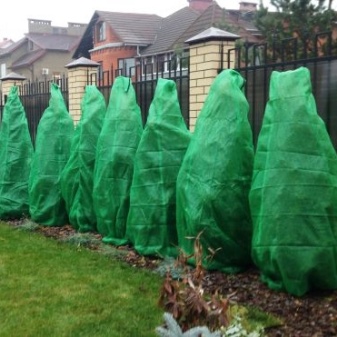
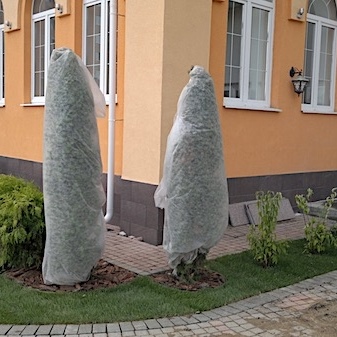
If the tree is older than 3 years, you do not need to wrap it up. But so that the branches do not break under the weight of snow or in strong winds, they are tied. And also during the winter you need to shake off the snow from time to time.
To protect the thuja from sunburn, you should organize additional protection. To this end, until complete thawing occurs, the coniferous plant must be covered with some kind of material: camouflage net, burlap, lutrasil, kraft paper. You can even use a regular sheet. Sometimes it is enough to protect the tree only from the sunny side. It is not necessary to wrap too tightly to provide air access.
To prevent the appearance and spread of fungal infections in the spring, you need to spray the plantings with fungicides. Bordeaux liquid or other preparations containing copper will do. In clayey areas where moisture can accumulate, the procedure should be repeated in the summer.
Conifers are characterized by such a fungal infection as brown shute. Most often, young plants suffer from it. The disease is detected after the snow melts. It is manifested by the appearance of yellow spots on the needles. Soon, the needles will have a yellow-brown color, it will be replaced by a bloom of gray-black. To prevent this from happening, in the spring they save from yellowing with the help of "Fitosporin".
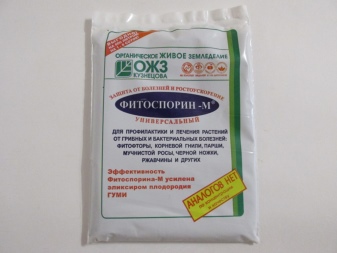
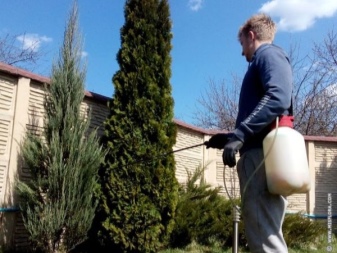
In addition, in the spring, thuja should be treated with insecticides against yellowing caused by pest infestations. Their appearance can be prevented. The soil around the trunk must be periodically carefully loosened, weeds removed and, if necessary, treated against insects.
About why the thuja turns yellow and how to save it, see the next video.



































































The comment was sent successfully.